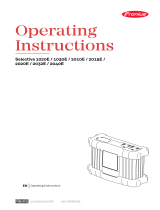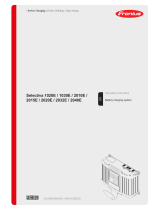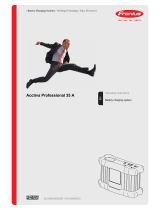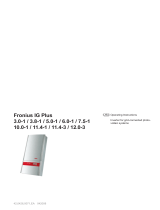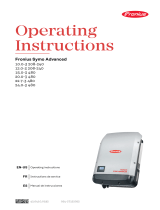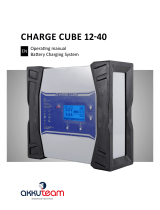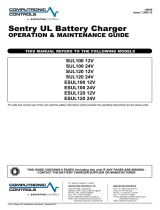Page is loading ...

Fronius prints on elemental chlorine free paper (ECF) sourced from certified sustainable forests (FSC).
/ Perfect Charging / Perfect Welding / Solar Energy
42,0426,0357,EN 001-25022020
Selectiva 4.0
2 - 3 kW
[
Operating Instructions
Battery charging system
EN

2

3
EN
Contents
Power categories ....................................................................................................................................... 5
General ................................................................................................................................................. 5
2 kW...................................................................................................................................................... 5
3 kW...................................................................................................................................................... 5
Safety rules ................................................................................................................................................ 6
General ................................................................................................................................................. 6
Environmental conditions...................................................................................................................... 6
Grid connection..................................................................................................................................... 6
Dangers from mains current and charging current ............................................................................... 7
Danger due to acid, gases and vapours ............................................................................................... 7
General information regarding the handling of batteries....................................................................... 8
Protecting yourself and others .............................................................................................................. 8
Safety measures in normal operation ................................................................................................... 8
EMC Device Classifications .................................................................................................................. 9
EMC measures ..................................................................................................................................... 9
Data protection...................................................................................................................................... 9
Maintenance ......................................................................................................................................... 9
Repair ................................................................................................................................................... 9
Obligations of the operator.................................................................................................................... 9
Safety inspection................................................................................................................................... 10
Markings on the device ......................................................................................................................... 10
Disposal ................................................................................................................................................ 10
Copyright............................................................................................................................................... 10
General information ................................................................................................................................... 11
Explanation of safety notices ................................................................................................................ 11
Device concept ..................................................................................................................................... 11
Proper use ............................................................................................................................................ 11
Grid connection..................................................................................................................................... 12
Charging lead........................................................................................................................................ 13
Correct arrangement of the mains/charging leads................................................................................ 13
Warning notices on the device.............................................................................................................. 13
Warning notices inside the device ........................................................................................................ 14
Setup regulations .................................................................................................................................. 15
Wall and floor bracket ........................................................................................................................... 16
Control elements and connections............................................................................................................. 20
Controls and connections ..................................................................................................................... 20
Pin assignment of the 2 kW option plug................................................................................................ 22
Pin assignment of the 3 kW option plug................................................................................................ 23
Control panel......................................................................................................................................... 24
Charging the battery .................................................................................................................................. 26
Starting for the first time........................................................................................................................ 26
Charging ............................................................................................................................................... 27
Interrupting the charging process ......................................................................................................... 29
Stopping charging ................................................................................................................................. 29
Display ....................................................................................................................................................... 31
Overview of modes ............................................................................................................................... 31
Standard mode ..................................................................................................................................... 32
Menu selection...................................................................................................................................... 32
Statistics mode...................................................................................................................................... 32
History mode......................................................................................................................................... 33
Configuration mode............................................................................................................................... 34
Settings ................................................................................................................................................. 37
Electrolyte circulation ............................................................................................................................ 38
Temperature-controlled charging.......................................................................................................... 39
Equalising charge ................................................................................................................................. 40
Delay..................................................................................................................................................... 40
Calendar ............................................................................................................................................... 41
Special charges .................................................................................................................................... 43
“Opportunity Charge” special function .................................................................................................. 43
DC connection ...................................................................................................................................... 44

4
Additional functions............................................................................................................................... 45
General options..................................................................................................................................... 47
Reset settings ....................................................................................................................................... 47
USB mode............................................................................................................................................. 48
Status codes ......................................................................................................................................... 49
Options....................................................................................................................................................... 54
Safety.................................................................................................................................................... 54
Electrolyte circulation 3 kW................................................................................................................... 54
External start/stop ................................................................................................................................. 56
Temperature-controlled charging.......................................................................................................... 56
LED strip ............................................................................................................................................... 56
Air filter.................................................................................................................................................. 57
Wall and floor bracket ........................................................................................................................... 57
"Mobile" kit ............................................................................................................................................ 57
Option box............................................................................................................................................. 57
Fitting plate ........................................................................................................................................... 58
Remote control system ......................................................................................................................... 59
GatewayLink ......................................................................................................................................... 59
Gateway................................................................................................................................................ 59
Technical data............................................................................................................................................ 60
Selectiva 2 kW ...................................................................................................................................... 60
Selectiva 3 kW ...................................................................................................................................... 61

5
EN
Power categories
General The kW information for the power categories relates to the housing design and is not di-
rectly related to the actual device output.
2 kW Selectiva
2040/2050/2060/2070
4020/4035
3 kW Selectiva
2080/2100/2120
4045/4060

6
Safety rules
General The device is manufactured using state-of-the-art technology and according to recognised
safety standards. If used incorrectly or misused, however, it can cause:
- Injury or death to the operator or a third party
- Damage to the device and other material assets belonging to the operator
- Inefficient operation of the device
All persons involved in commissioning, operating, maintaining and servicing the device
must:
- Be suitably qualified
- Read and follow these Operating Instructions carefully
The Operating Instructions must always be at hand wherever the device is being used. In
addition to the Operating Instructions, attention must also be paid to any generally appli-
cable and local regulations regarding accident prevention and environmental protection.
All safety and danger notices on the device:
- Must be in a legible state,
- Must not be damaged,
- Must not be removed,
- Must not be covered, pasted or painted over.
For the location of the safety and danger notices on the device, refer to the section headed
"General information" in the Operating Instructions for the device.
Before switching on the device, rectify any faults that could compromise safety.
This is for your personal safety!
Environmental
conditions
Operation or storage of the device outside the stipulated area will be deemed as not in ac-
cordance with the intended purpose. The manufacturer shall not be held liable for any dam-
age arising from such usage.
For exact information on permitted environmental conditions, please refer to the "Technical
data" section.
Grid connection Devices with a higher rating may affect the energy quality of the mains due to their current
consumption.
This may affect device types in terms of:
- Connection restrictions, requirements regarding permitted mains impedance *)
- Requirements with regard to the minimum short-circuit power requirement *)
.
*) at the interface with the public grid
see "Technical data"
In this case, the plant operator or the person using the device should check whether the
device may be connected, possibly by discussing the matter with the power supply com-
pany where appropriate.
IMPORTANT! Ensure that the grid connection is earthed properly!

7
EN
Dangers from
mains current
and charging cur-
rent
Anyone working with chargers exposes themselves to numerous dangers e.g.:
- Risk of electrocution from mains current and charging current.
- Hazardous electromagnetic fields, which can risk the lives of those using cardiac
pacemakers.
An electric shock can be fatal. Every electric shock is potentially life threatening. To avoid
electric shocks while using the charger:
- Do not touch any live parts inside or on the outside of the charger.
- Under no circumstances touch the battery poles.
- Do not short-circuit the charging lead or charging terminals.
All cables and leads must be secured, undamaged, insulated and adequately dimen-
sioned. Loose connections, scorched, damaged or inadequately dimensioned cables and
leads must be immediately repaired by authorised personnel.
Danger due to ac-
id, gases and va-
pours
Batteries contain acid which is harmful to the eyes and skin. During charging, gases and
vapours are released that may be harmful to health and are highly explosive in certain cir-
cumstances.
Only use the charger in well-ventilated areas to prevent the accumulation of explosive gas-
es. Battery rooms are not deemed to be hazardous areas provided that a concentration of
hydrogen of less than 4% can be guaranteed by the use of natural or forced ventilation.
Maintain a distance of at least 0.5 m (19.69 in.) between the battery and charger during the
charging procedure. Possible sources of ignition such as fire and naked flames must be
kept away from the battery.
The battery connection (e.g. charging terminals) must not be disconnected for any reason
during charging.
Do not inhale any of the gases and vapours released under any circumstances - Make sure
the area is well ventilated.
To prevent short circuits, do not place any tools or conductive metals on the battery.
Battery acid must not get into the eyes or onto the skin or clothes. Wear protective goggles
and suitable protective clothing. Rinse any acid splashes thoroughly with clean water and
seek medical advice if necessary.

8
General informa-
tion regarding the
handling of bat-
teries
- Protect batteries from dirt and mechanical damage.
- Store charged batteries in a cool place. Self discharge is kept to a minimum at approx.
+2 °C (35.6 °F).
- Carry out a visual inspection at least once a week or as often as specified by the bat-
tery manufacturer to ensure that the acid (electrolyte) level in the battery is at the max.
mark.
- If any of the following occur, do not start the device (or stop immediately if already in
use) and have the battery checked by an authorised workshop:
- uneven acid levels and/or high water consumption in individual cells caused by a
possible fault.
- overheating of the battery above 55 °C (131 °F).
Protecting your-
self and others
While the charger is in operation, keep all persons, especially children, out of the working
area. If, however, there are people in the vicinity,
- warn them about all the dangers (hazardous acids and gases, danger from mains and
charging current, etc.),
- provide suitable protective equipment.
Before leaving the work area, ensure that people or property cannot come to any harm in
your absence.
Safety measures
in normal opera-
tion
Chargers with a ground conductor must only be operated on a mains supply with a ground
conductor and a socket with a ground conductor contact. If the charger is operated on a
mains supply without a ground conductor or in a socket without a ground conductor con-
tact, this will be deemed gross negligence. The manufacturer shall not be held liable for
any damage arising from such usage.
Only operate the charger in accordance with the degree of protection shown on the rating
plate.
Never operate the charger if there is any evidence of damage.
Arrange for the mains cable to be checked regularly by a qualified electrician to ensure the
ground conductor is functioning properly.
Any safety devices and parts that are not functioning properly or are in imperfect condition
must be repaired by a qualified technician before switching on the charger.
Never bypass or disable protection devices.
After installation, an accessible mains plug is required.

9
EN
EMC Device Clas-
sifications
Devices in emission class A:
- Are only designed for use in industrial settings.
- Can cause line-bound and radiated interference in other areas.
Devices in emission class B:
- Satisfy the emissions criteria for residential and industrial areas. This is also true for
residential areas in which the energy is supplied from the public low-voltage mains.
EMC device classification as per the rating plate or technical data.
EMC measures In certain cases, even though a device complies with the standard limit values for emis-
sions, it may affect the application area for which it was designed (e.g. when there is sen-
sitive equipment at the same location, or if the site where the device is installed is close to
either radio or television receivers).
If this is the case, then the operating company is obliged to take appropriate action to rectify
the situation.
Data protection The user is responsible for the safekeeping of any changes made to the factory settings.
The manufacturer accepts no liability for any deleted personal settings.
Maintenance Before switching on, always check the mains plug and cable as well as charger leads and
charging terminals for any signs of damage.
If the surface of the device housing is dirty, clean with a soft cloth and solvent-free cleaning
agent only.
Repair Repair work must only be carried out by authorised personnel. Use only original replace-
ment and wearing parts (also applies to standard parts). It is impossible to guarantee that
bought-in parts are designed and manufactured to meet the demands made on them, or
that they satisfy safety requirements.
Do not carry out any modifications, alterations, etc. to the device without the manufactur-
er's consent.
Obligations of the
operator
The operator must only allow persons to work with the device who:
- Are familiar with the fundamental instructions regarding safety at work and accident
prevention and have been instructed in how to use the device.
- Have read and understood these operating instructions, especially the section "safety
rules", and have confirmed as much with their signatures.
- Are trained to produce the required results.
Checks must be carried out at regular intervals to ensure that operators are working in a
safety-conscious manner.

10
Safety inspection The manufacturer recommends that a safety inspection of the device is performed at least
once every 12 months.
A safety inspection should be carried out by a qualified electrician
- after any changes are made,
- after any additional parts are installed, or after any conversions,
- after repair, care and maintenance has been carried out,
- at least every 12 months.
For safety inspections, follow the appropriate national and international standards and di-
rectives.
Further details on safety inspections can be obtained from your service centre. They will
provide you, on request, with any documents you may require.
Markings on the
device
Devices with the CE marking satisfy the essential requirements of the applicable guide-
lines.
Devices displaying the EAC mark of conformity satisfy the requirements of the relevant
standards in Russia, Belarus, Kazakhstan, Armenia and Kyrgyzstan.
Disposal Do not dispose of the product in domestic waste. Dispose of it according to the disposal
requirements for waste electrical and electronic equipment valid at the installation site.
Copyright Copyright of these operating instructions remains with the manufacturer.
The text and illustrations are all technically correct at the time of printing. We reserve the
right to make changes. The contents of the operating instructions shall not provide the ba-
sis for any claims whatsoever on the part of the purchaser. If you have any suggestions for
improvement, or can point out any mistakes that you have found in the instructions, we will
be most grateful for your comments.

11
EN
General information
Explanation of
safety notices DANGER!
Indicates immediate danger.
► If not avoided, death or serious injury will result.
WARNING!
Indicates a potentially hazardous situation.
► If not avoided, death or serious injury may result.
CAUTION!
Indicates a situation where damage or injury could occur.
► If not avoided, minor injury and/or damage to property may result.
NOTE!
Indicates a risk of flawed results and possible damage to the equipment.
Device concept The single-phase battery charging systems for 24 V and 48 V batteries are fitted with intel-
ligent charging technology. The successful Active Inverter Technology with the revolution-
ary Ri charging process adapts itself to the requirements of the battery and only charges
the battery with the current that it actually needs.
The technology is embedded in a robust industry-standard housing. The exceptionally
compact design complies with all safety standards, requires less installation space and
protects the components to ensure a long service life.
Fitted with a graphical display, an integrated datalogger, new interfaces and additional op-
tions, the device is perfectly equipped for the future.
Proper use The charger is designed to charge the batteries listed below. Any use above and beyond
this purpose is deemed improper. The manufacturer is not liable for any damage resulting
from such use. Proper use also includes:
- Following all the instructions contained in the Operating Instructions,
- Regularly checking the mains cable and charging leads.
WARNING!
Danger from charging dry batteries (primary cells) and non-rechargeable batteries.
This can result in serious injury and damage to property.
► Only charge the battery types listed below.

12
WARNING!
Danger due to unsuitable batteries being connected to the charger.
Escaping gas, fire or explosion may result in serious injury and damage to property.
► Never connect a battery to the charger unless it is compatible in terms of its type, volt-
age and capacity and corresponds to the charger settings.
The charger is intended for charging lead-acid batteries and NiCd batteries. Set the charg-
er to the type of battery to be charged:
- Pb-WET batteries (PzS, GiS, ...):
Venting, closed lead-acid wet batteries with liquid electrolyte.
- Pb-GEL batteries (PzV, GiV, ...):
Valve-regulated, sealed lead-acid batteries (VRLA) with fixed electrolyte (gel or non-
woven fabric).
- NiCd batteries:
Closed or sealed NiCd batteries with liquid electrolyte.
- Pb-CSM-WET batteries (copper strained metal):
Closed lead-acid CSM batteries with liquid electrolyte.
- Lead crystal batteries:
EVFJ/CNFJ-type lead crystal batteries.
Proper handling of the device is essential for it to function correctly. Never pull on the cable
when handling the device.
Grid connection WARNING!
Danger from electric current.
This can result in serious injury or death.
► Before starting work, switch off all the devices and components involved and discon-
nect them from the grid.
► Secure all the devices and components involved to prevent unintentional restarting.
WARNING!
Danger due to incorrect operation and incorrectly performed work.
This can result in serious injury and damage to property.
► All the work and functions described in this document must only be carried out by
trained and qualified personnel.
► Read and understand this document.
► Read and understand all the Operating Instructions for the system components, espe-
cially the safety rules.
WARNING!
Danger due to faulty or insufficient power supply.
This can result in serious injury and damage to property.
► The power supply requirements detailed in "Technical data" must be met.

13
EN
Charging lead WARNING!
Danger due to trailing charging leads.
This may result in serious injury and damage to property. People may become entangled
in or trip over loose, unwound cables
► Lay the charging leads so that no one can trip over or become entangled in them.
WARNING!
Danger due to the charging plug being pulled out during the charging process.
This may result in serious injury and damage to property. The sparks caused by this can
ignite the charging gases that build up during the charging process, causing a fire or an
explosion.
► Once the charging process is complete, wind up the charging leads, or if available,
place them on the cable holder.
Correct arrange-
ment of the
mains/charging
leads
CAUTION!
Danger due to overheating caused by laying the mains/charging leads incorrectly.
Risk of damage to the components.
► Lay mains/charging lead without loops.
► Do not cover mains/charging lead.
Warning notices
on the device
A number of safety symbols can be seen on the charger's rating plate. These safety sym-
bols must not be removed or painted over.

14
Warning notices
inside the device WARNING!
Danger from electric shocks.
This can result in serious injury or death.
► The housing must never be opened by anyone other than a service technician trained
by the manufacturer.
► The device must be disconnected from the mains before starting any work with the
housing open. A suitable measuring instrument must be used to ensure that electrically
charged components (e.g. capacitors) are fully discharged.
► Use an easily legible and understandable warning sign to ensure that the device is not
reconnected to the mains supply before all the work has been completed.
Inside the device:
Do not dispose of used devices with domestic waste. Dispose of them according
to the safety rules.
Possible sources of ignition, such as fire, sparks and naked flames, must be kept
away from the battery.
Risk of explosion! Oxyhydrogen is generated in the battery during charging.
Battery acid is corrosive and must be kept away from eyes, skin and clothes.
Ensure an adequate supply of fresh air during charging.
Do not use the functions until you have fully read the Operating Instructions.
Ladevorgang immer stoppen bevor das Ladekabel abgezogen wird!
Explosive Gase. Flammen und Funken vermeiden.
Während des Ladens für ausreichend Frischluft-Zufuhr sorgen!
Always stop charging before you disconnect the charging cable!
Explosive gases. Prevent flames and sparks.
Provide adequate ventilation during charge!
Toujours arrêter la charge avant de déconnecter le câble de charge!
Gaz explosifs. Éviter les flammes et les étincelles.
Prévoir une ventilation adaptée pendant la charge!
¡Detener siempre la carga antes de desconectar el cable de carga!
Gases explosivos. Evitar llamas y chipas.
¡Mantener una ventilación adecuada durante la carga!
Interrompere sempre la carica prima di scollegare il cavo di carica!
Gas esplosivi. Evitare fiamme libere e scintille.
Predisporre una ventilazione adeguata durante la carica!
WARNUNG - WARNING - ATTENTION
ADVERTENCIA - AVVISO
42,0409,0419
IP21
1~ NPE 230V 50/60Hz
xxA
xxV
xxxxW
xxA
www.fronius.com
xxxxxxxx
XXXX
xxxxxxxx
4,010,xxx
Selectiva x.0 xxxx xkW
OVC III
U
AC nom.
I
AC max.
P
AC max.
UDC nom.
IDC max.
Part No.:
Ser. No.:
Protective class I
Fronius International GmbH
Froniusstraße 1
4643 Pettenbach
Austria

15
EN
Setup regulations WARNING!
Danger from machines falling or toppling over.
This can result in serious injury and damage to property.
► Make sure that all system components are securely in position when setting them up.
► If using a floor bracket or wall bracket, always make sure that all the fastenings are se-
cure.
The device is tested to "Degree of protection IP21", meaning:
- Protection against penetration by solid foreign bodies with diameters exceeding 12.5
mm (0.49 in.)
- Protection against vertically falling drops of water
The device can be set up and operated in dry, closed areas that comply with degree of pro-
tection IP21. Exposure to wet conditions should be avoided.
The device may only be operated in a hori-
zontal position.
2 kW
4,010,xxx
xxxxxxxx
XXXX
UDC nom. xxV
Part No.:
Ser. No.:
1
2
1 Display
2 Battery CR2032
WARNING Hazardous Voltage
Kondensator Entladezeit < 2 min.
Capacitor discharge time < 2 min.
Décharge de condensateur < 2 min.
Condensador tiempo de descarga < 2 min.
Condensatore tempo di scaricamento < 2 min.
3 kW
4,010,xxx
xxxxxxxx
XXXX
U
DC nom.
xxV
Part No.:
Ser. No.:
12
1 Display
2 Battery CR2032
WARNING Hazardous Voltage
Kondensator Entladezeit < 2 min.
Capacitor discharge time < 2 min.
Décharge de condensateur < 2 min.
Condensador tiempo de descarga < 2 min.
Condensatore tempo di scaricamento < 2 min.

16
The air surrounding the charger must be kept free from battery acid vapour as far as pos-
sible. You should therefore avoid mounting the device directly above the battery that is to
be charged.
Cooling air
The charger must be set up in such a way that the cooling air can flow unimpeded through
the vents in the housing that are provided for that purpose. Ensure that there is always a
minimum clearance of 20 cm (7.87 in.) around the air inlets and outlets. The surrounding
air must be free from
- Excessive dust
- Electrically conductive particles (carbon black or swarf)
- Heat sources
Cooling air is drawn in and flows out as indicated by the arrows in the following illustrations.
NOTE!
Danger due to partially or fully covered air inlets and outlets.
This can result in damage to property.
► If several chargers are set up one behind the other, they should be offset.
If the chargers are arranged in a line one behind the other without being offset, the space
between the chargers must be as follows:
- Minimum distance 20 cm (7.87 in.)
Wall and floor
bracket WARNING!
Danger due to work that has been carried out incorrectly and falling devices.
This can result in serious injury and damage to property.
► This installation must only be carried out by trained and qualified personnel.
► Take note of the safety rules in the charger Operating Instructions.
Different wall plugs and screws are required depending on the supporting surface. Wall
plugs and screws are therefore not included in the scope of supply. The installer is respon-
sible for selecting the correct wall plugs and screws.
20 cm (7.87 in.)

17
EN
WARNING!
Danger due to objects falling or toppling over.
This can result in serious injury and damage to property.
► Ensure that all screw connections are secure.
► Use only with the charger provided by the manufacturer.
► Ensure that the device is level when mounting.
► If the device is mounted on the wall, ensure the wall is capable of supporting the weight
of the device.
1 2
Weight of wall bracket:
2 kW 1.10 kg (2.43 lb)
3 kW 1.35 kg (2.98 lb)
1
*
TX25
3
3
3
*
*
2

18
2 kWmm (in.)
341 (13.43)
182 (7.17)
38 (1.5) 123,5 (4.86) 91,5 (3.6)
8.5 (.33)
220 (8.66) 123 (4.84)
110 (4.33)
198 (7.8)
283 (11.14)
38 (1.5) 24,5 (.96)
11 (.43)
8.5 (.33)
90 (3.54)
76 (2.99)
20 (.79)
20 (.79)
266 (10.47)

19
EN
3 kWmm (in.)
417 (16.42)
182 (7.17)
38 (1.5) 123,5 (4.86)
40 (1.57) 89,5 (3.52)38 (1.5)
11 (.43)
8,5 (.33)
342 (13.46)
220 (8.66)
123 (4.84)
110 (4.33)
198 (7.8)
283 (11.14)
38 (1.5)
20 (.79) 90 (3.54)
38 (1.5)
20 (.79)
24,5 (.96)
76 (2.99)

20
Control elements and connections
Controls and con-
nections
No. Function
(1) USB port
The USB port allows a USB flash drive to be used to update the device and also to
log the charging parameters while charging is in progress.
(2) Position for options
- External start/stop option
- Temperature-controlled charging option
(3) (-) Charging lead
(4) (+) Charging lead
(5) Mains cable
(6) Position for electrolyte circulation option
(3) (4)
(1)
(2)
(2)
(5)
(6)
/
